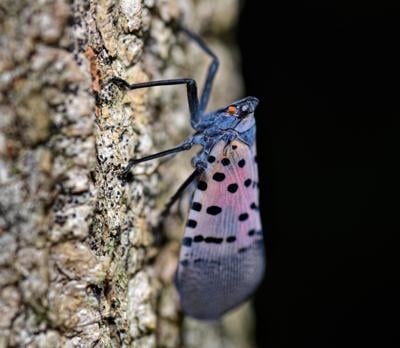Where are all the spotted lanternflies in Lancaster County?
The short answer is: no one knows.
State experts have been studying the invasive insects’ developments over the past decade, from their 2014 discovery in Berks County to their spread across 51 of Pennsylvania’s 67 counties.
One of those experts, horticulture educator Amy Korman with the Penn State Extension, said there are a number of factors that impact where a population calls home: its biology, the environment’s resources and current weather.
With spotted lanternflies, native to Southeast Asia, as relatively new to Pennsylvania, a lot of that impact is hard to gauge, Korman said.
“The answer is, we don’t know,” Korman said of their whereabouts in Lancaster County this season. “If we knew that, I’d be a zillionaire by now.”
Through the end of July, there were only 69 reports of lanternflies in Lancaster, according to the state Department of Agriculture. By July 11, 2022, the department had 438 reports and 176 by July 11, 2021.
Reporting tends to drop off as lanternfly sightings become more frequent, according to Korman.
Public reports aren’t an exact measure of populations, press secretary Shannon Powers also said. There isn’t a pattern yet of where lanternflies are seen in droves, but in many urban areas, the lanternfly population reports peaked in the third year.
Spotted lanternflies eat sap from over 70 types of plants, and when their populations in one area are high, can cause significant damage. The insect also produces honeydew which attracts other insects and creates an environment for excessive fungi growth.
Eggs hatch around April, May and June, Korman said, but people don’t typically notice a lot of them until late August when all the eggs are full-grown adults. The two nymph stages, where the bugs can’t fly but jump, come between.
The insect is found in new locations every year because people are accidentally taking them there, Korman said. All 51 counties where the lanternfly has been spotted are under a state-imposed quarantine to stop the excursion, which includes inspection of vehicles and transported items, as well as required permits for businesses that move products “within or from” the quarantine zone.
"It’s not like the population is picking up and moving. It's just spreading outward from where it started …" Korman said. "Taking it there on trains and on cars and on trucks and equipment and any other materials as well."
Spotted lanternflies are also in New Jersey, New York, Ohio, Connecticut, Maryland, Delaware, Virginia and West Virginia. Korman added they’re worried about the insect ending up in California, for example, where they could impact the grape crops.
“These are the things that we talk to the public about, so that people are aware of what's going on and can very consciously think about, ‘I'm in a place where there are lots of spotted lanternflies. How do I avoid participating in moving them from one place to another?” Korman said.
According to Korman, even if they aren’t noticeable, they’re still there. The guidance remains to kill the ones you see.
“If you see one, the only good one is a dead one,” Korman said. “So if people wanna contribute to the dead ones, that’s all fine by me.”
If you observe a spotted lanternfly, report it online to the Pennsylvania Department of Agriculture or call Penn State Extension at 888-422-3359.



 ANN REJRAT | Staff Writer
ANN REJRAT | Staff Writer![Which chemicals kill spotted lanternflies but won't harm plants? This science fair winner has the results [video]](https://bloximages.newyork1.vip.townnews.com/lancasteronline.com/content/tncms/assets/v3/editorial/0/87/087cf59c-1b0d-11ec-b069-9737ffc29419/614a29dd420e1.image.jpg?resize=150%2C108)
 ERIN NEGLEY | Staff Writer
ERIN NEGLEY | Staff Writer![Lancaster County woman talks using TikTok to educate her followers about spotted lanternflies [Q&A]](https://bloximages.newyork1.vip.townnews.com/lancasteronline.com/content/tncms/assets/v3/editorial/1/c9/1c9cd72c-2af2-11ed-b7e2-878b0bc93faf/631254472f48e.image.jpg?resize=150%2C104)


